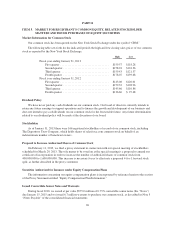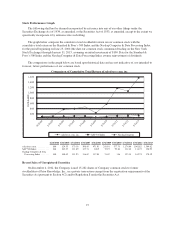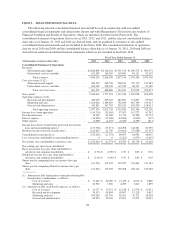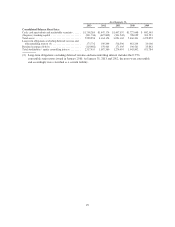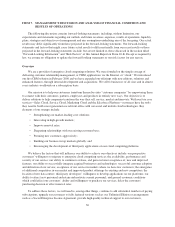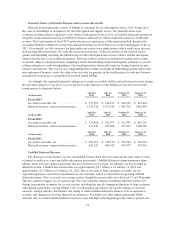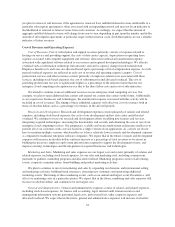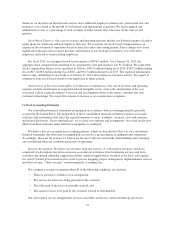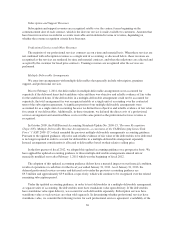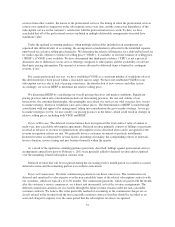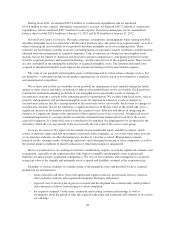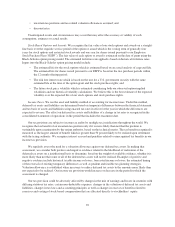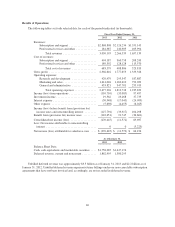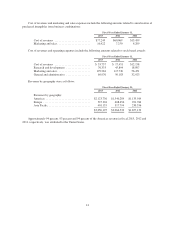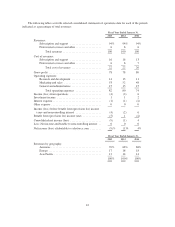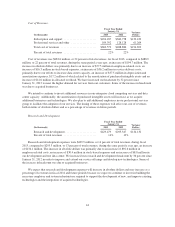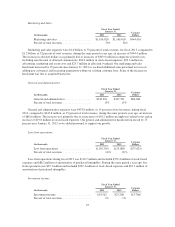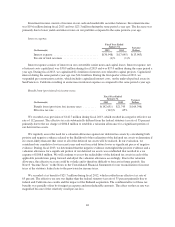Salesforce.com 2013 Annual Report Download - page 40
Download and view the complete annual report
Please find page 40 of the 2013 Salesforce.com annual report below. You can navigate through the pages in the report by either clicking on the pages listed below, or by using the keyword search tool below to find specific information within the annual report.Subscription and Support Revenues
Subscription and support revenues are recognized ratably over the contract terms beginning on the
commencement date of each contract, which is the date our service is made available to customers. Amounts that
have been invoiced are recorded in accounts receivable and in deferred revenue or revenue, depending on
whether the revenue recognition criteria have been met.
Professional Services and Other Revenues
The majority of our professional services contracts are on a time and material basis. When these services are
not combined with subscription revenues as a single unit of accounting, as discussed below, these revenues are
recognized as the services are rendered for time and material contracts, and when the milestones are achieved and
accepted by the customer for fixed price contracts. Training revenues are recognized after the services are
performed.
Multiple-Deliverable Arrangements
We enter into arrangements with multiple-deliverables that generally include subscription, premium
support, and professional services.
Prior to February 1, 2011, the deliverables in multiple-deliverable arrangements were accounted for
separately if the delivered items had standalone value and there was objective and reliable evidence of fair value
for the undelivered items. If the deliverables in a multiple-deliverable arrangement could not be accounted for
separately, the total arrangement fee was recognized ratably as a single unit of accounting over the contracted
term of the subscription agreement. A significant portion of our multiple-deliverable arrangements were
accounted for as a single unit of accounting because we did not have objective and reliable evidence of fair value
for certain of our deliverables. Additionally, in these situations, we deferred the direct costs of a professional
services arrangement and amortized those costs over the same period as the professional services revenue is
recognized.
In October 2009, the FASB issued Accounting Standards Update No. 2009-13, “Revenue Recognition
(Topic 605), Multiple-Deliverable Revenue Arrangements—a consensus of the FASB Emerging Issues Task
Force” (“ASU 2009-13”) which amended the previous multiple-deliverable arrangements accounting guidance.
Pursuant to the updated guidance, objective and reliable evidence of fair value of the deliverables to be delivered
is no longer required in order to account for deliverables in a multiple-deliverable arrangement separately.
Instead, arrangement consideration is allocated to deliverables based on their relative selling price.
In the first quarter of fiscal 2012, we adopted this updated accounting guidance on a prospective basis. We
have applied the updated accounting guidance to those multiple-deliverable arrangements entered into or
materially modified on or after February 1, 2011 which was the beginning of fiscal 2012.
The adoption of this updated accounting guidance did not have a material impact on our financial condition,
results of operations or cash flows for the fiscal year ended January 31, 2012. As of January 31, 2013, the
deferred professional services revenue and deferred costs under the previous accounting guidance are
$9.3 million and approximately $3.9 million, respectively, which will continue to be recognized over the related
remaining subscription period.
Under the updated accounting guidance, in order to treat deliverables in a multiple-deliverable arrangement
as separate units of accounting, the deliverables must have standalone value upon delivery. If the deliverables
have standalone value upon delivery, we account for each deliverable separately. Subscription services have
standalone value as such services are often sold separately. In determining whether professional services have
standalone value, we consider the following factors for each professional services agreement: availability of the
36


